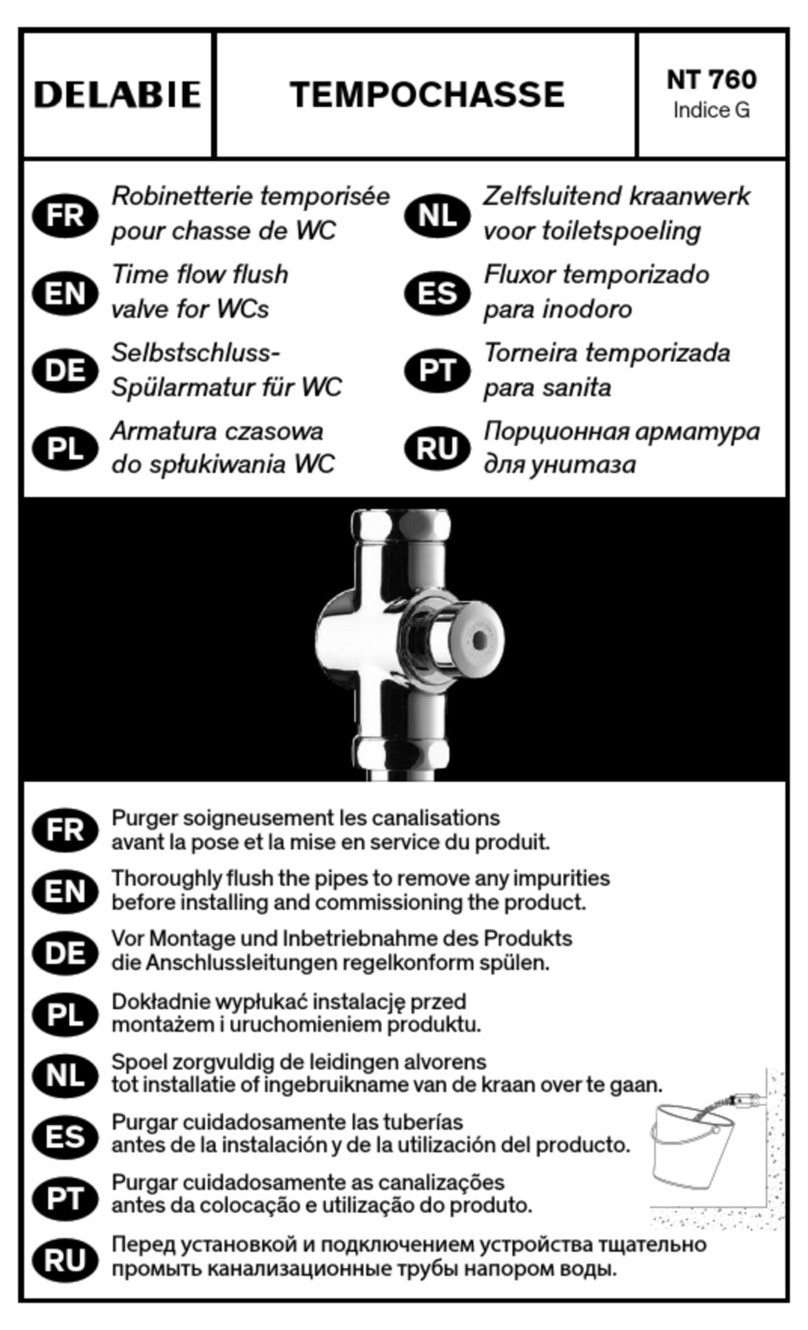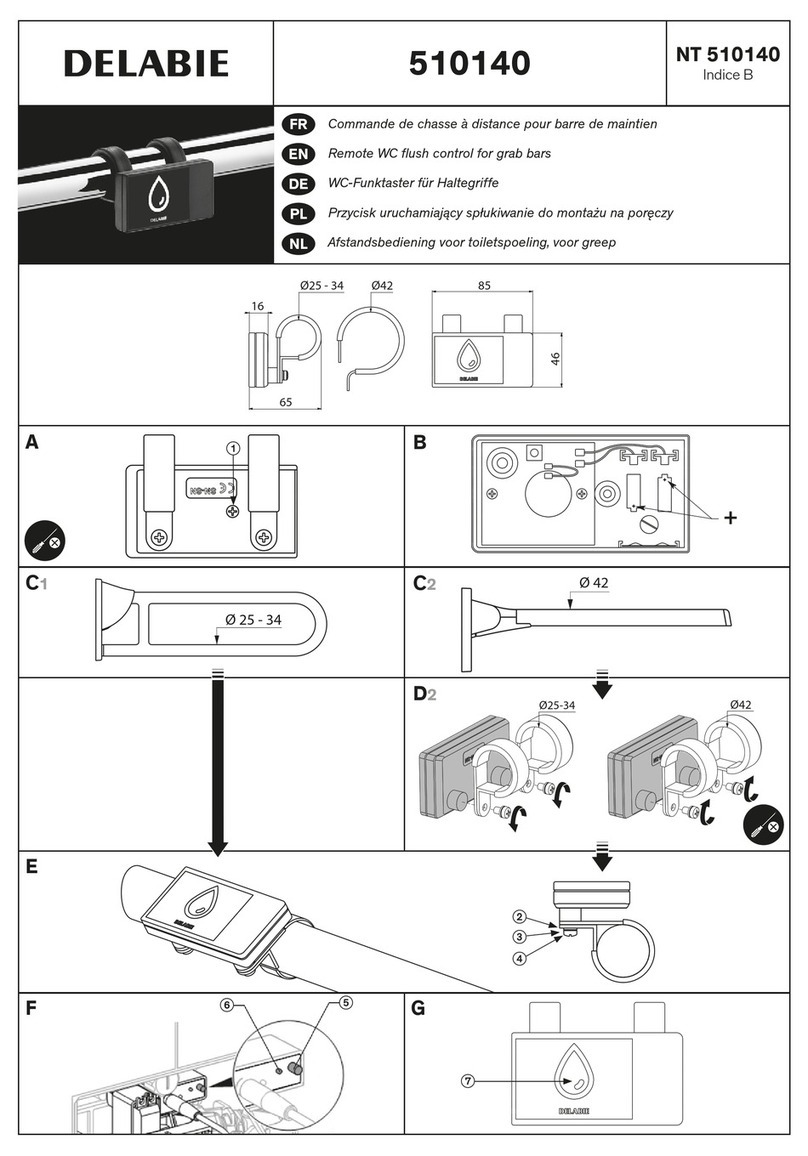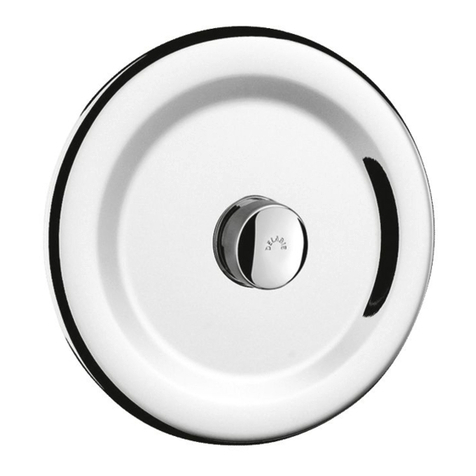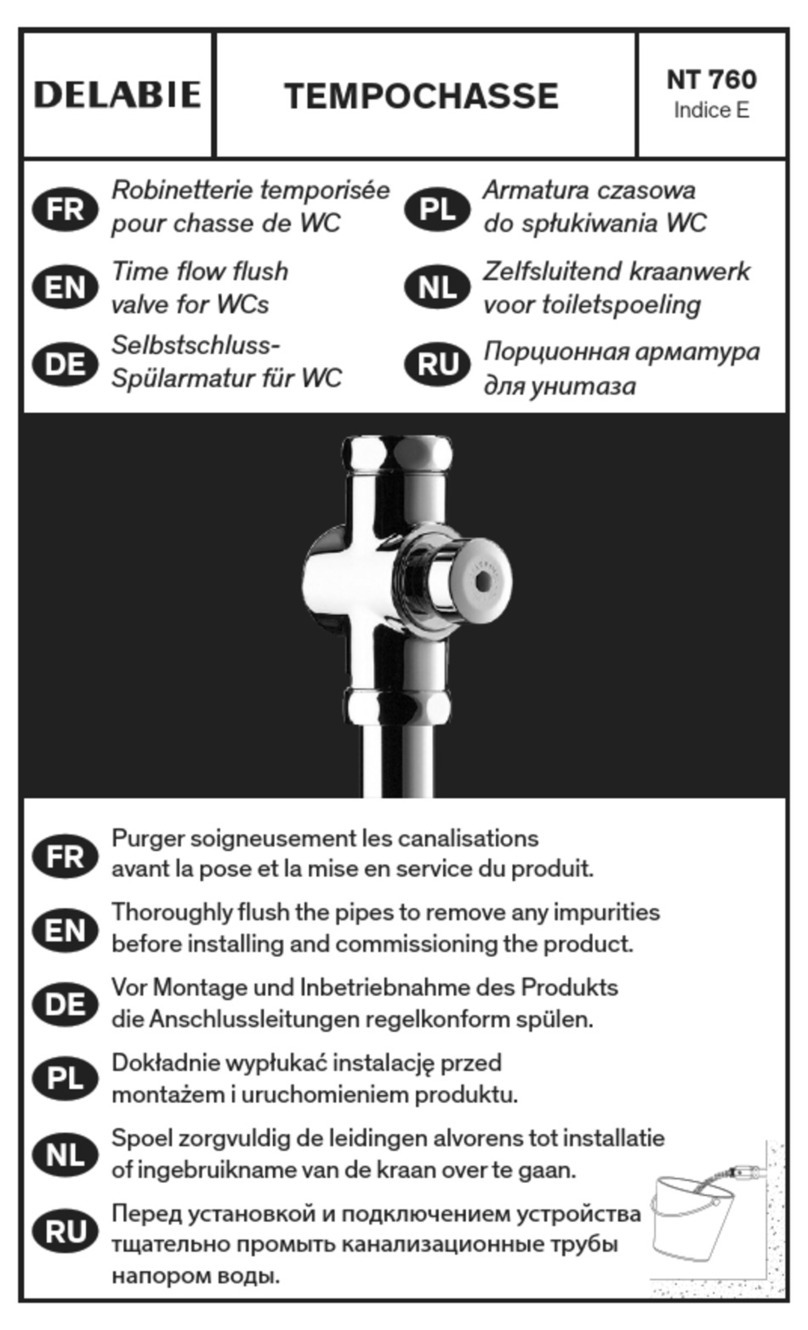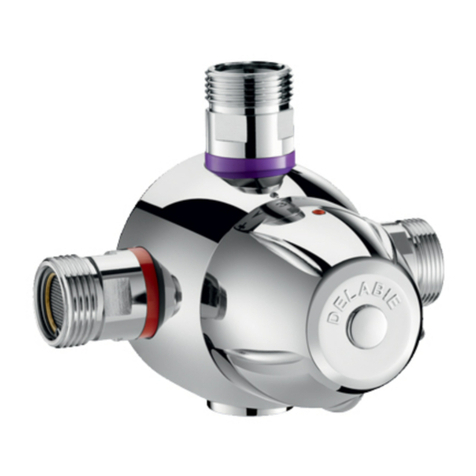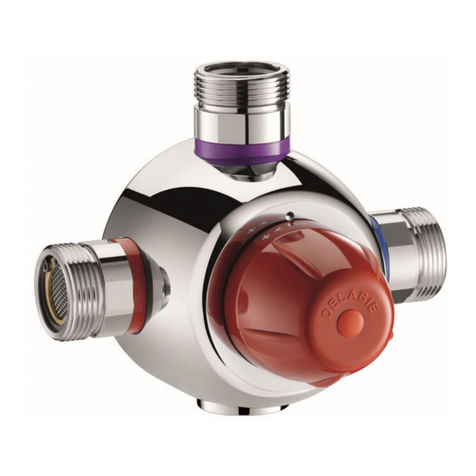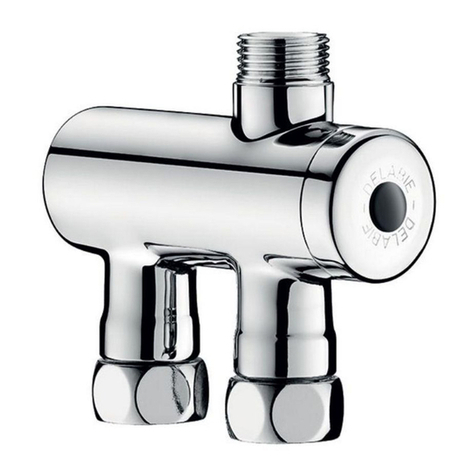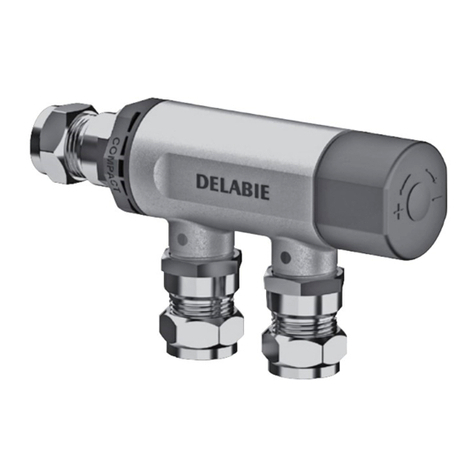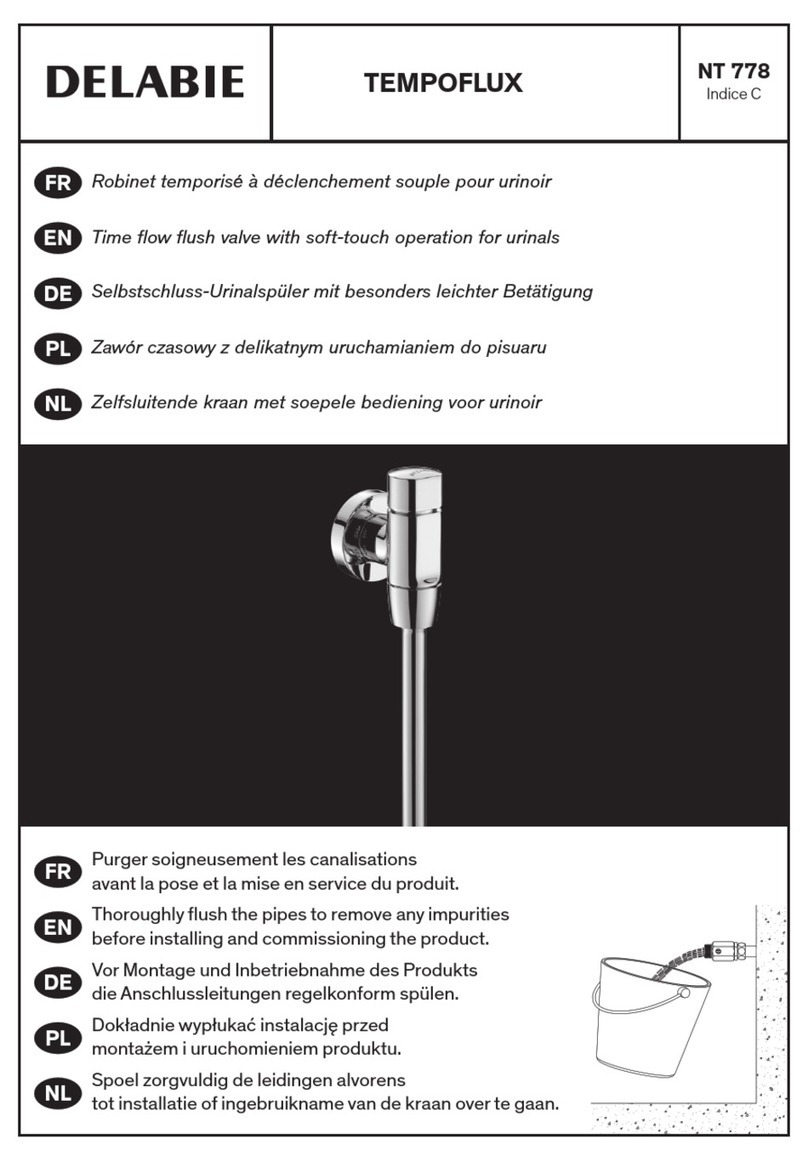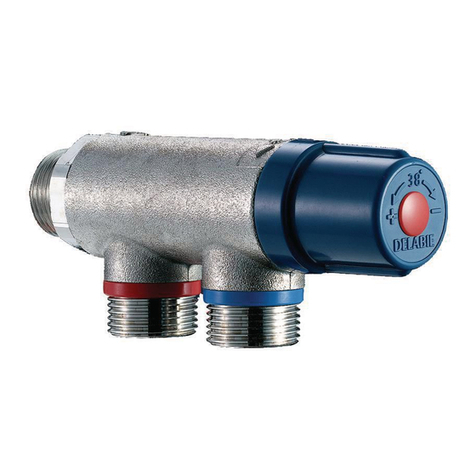
INSTALLATION (Fig. A et B)
ALIMENTATION ELECT IQUE
L'installation doit être conforme aux normes de votre pays (en France NF C 15-100).
• nstaller notre transformateur de sécurité (protégé par un fusible) réf. 406000, conforme à la norme EN 60742, dans un coffret électrique ou
sur le tableau électrique existant.
• Prévoir un moyen de séparation en amont du transformateur (ex. interrupteur sectionneur, porte fusible combiné, etc…).
• La tenue des câbles sera assurée par une pose fixe (collier ou gaines rigides).
• Raccorder le transformateur au module électronique par un câble normalisé de 2x1mm2.
• Fixer le boitier électronique (ME) sur le mur, hors zone humide, avec vis plus rondelle isolante.
• Raccorder le câble du détecteur sur la borne RMBN du module électrique :
- Fil rouge : borne R
- Fil bleu : borne M
- Fil blanc : borne B
- Fil noir : borne N
• nstaller le détecteur à 1 mètre du sol environ, et à 30 cm environ devant les urinoirs. Le détecteur est livré avec un câble blindé de longueur 5 mètres
maxi, ne pas couper ni rallonger le câble.
ALIMENTATION HYD AULIQUE (Fig.C)
• Pression recommandée de 1 à 5 bar dynamique maxi. Calculer le diamètre de tuyauterie en fonction du débit simultané de tous les urinoirs, et des
pertes de charge.
Débit nécessaire : 0,15 l/s pour un urinoir ordinaire - 0,5 l/s pour un urinoir siphonique
• Fixer le module hydraulique et le raccorder au réseau d'eau.
• Raccorder l'électrovanne du module hydraulique sur le câble repéré EV, utiliser câble 2 fils (2x0,75 mm2).
FONCTIONNEMENT/ EGLAGES (Fig. D)
• Mettre l'appareil sous tension, la LED jaune "12Vac" s'allume dans le boîtier électronique.
• Rechercher l'alignement du réflecteur en le déplaçant sur le mur, face à la cellule - distance de 1 à 6 mètres. La LED rouge dans le détecteur,
contrôlant l'alignement du barrage s'allume lorsque que le réflecteur est correctement positionné. Elle s'éteint quand le faisceau R est coupé.
• La LED verte, dans le boîtier électronique, s'allume quand l'électrovanne est excitée (faisceau .R. coupé).
• Régler le débit instantané total par le robinet d'arrêt du module hydraulique.
• Equilibrer les débits à chaque urinoir (voir limiteur 927 015).
• Régler la temporisation si nécessaire (5 à 15 sec.) par le potentiomètre (TEMPO) dans le boîtier électronique. l est conseillé de ne pas position-
ner le potentiomètre en butée maxi, ni en butée mini.
• Fonctionnement sans contact manuel.
• Pré-rinçage à lʼarrivée du premier usager (2 sec.).
inçage au bout de 60 secondes - prog. position 4 - (possibilité d'avoir un rinçage au bout de 30 secondes en plaçant le sélecteur PROG sur
la position 5).
• En cas d'affluence, rinçage toutes les 30 secondes ou toutes les minutes, sans prérinçage.
• Arrêt automatique en cas de malveillance ou après 20 cycles ininterrompus, l'appareil se met en sécurité. Remise en fonction dès que le fais-
ceau est rétabli.
• Cycle de rinçage journalier toutes les 12 heures.
APPEL
• Nos robinetteries doivent être installées par des installateurs professionnels en respectant les réglementations en vigueur, les prescriptions
des bureaux d’études fluides et règles de l’art.
• especter le diamètre des tuyauteries permet d'éviter les coups de bélier ou pertes de pression/débit (voir le tableau de calcul du catalogue et en
ligne sur www.delabie.fr).
• Protéger l'installation avec des filtres, antibéliers ou réducteurs de pression diminue la fréquence d'entretien (pression conseillée :
1 à 5 bar).
• Poser des vannes d'arrêt à proximité des robinets facilite les interventions de maintenance.
• Les canalisations, robinets d’arrêt, de puisage et tout appareil sanitaire doivent être vérifiés aussi souvent que nécessaire et au moins une fois par an.
ENT ETIEN & NETTOYAGE
• Nettoyage du chrome :
N’utilisez jamais d'abrasifs ou tout autre produit à base de chlore ou d'acide. Nettoyez à l’eau légèrement savonneuse, avec un chiffon ou une
éponge.
• Mise hors gel :
Purgez les canalisations, et actionnez plusieurs fois la robinetterie pour la vider de son contenu d'eau.
MAINTENANCE
• Construction modulaire : boîtier électronique, boîtier hydraulique, transformateur accessibles séparément.
Diagnostic aisé grâce aux voyants de bon fonctionnement (LED).
F
Service Après Vente et Assistance technique :
Tél.: +33 (0)3.22.60.22.74 e.mail : sav@delabie.fr
La dernière version à jour de cette notice est disponible sur www.delabie.fr.
INSTALACJA ( ys. A et B)
ZASILANIE ELEKT YCZNE
Instalacja musi być zgodna z normami w danym kraju (np. we Francji NF C 15-100).
• Zainstalować transformator bezpieczeństwa (chroniony bezpiecznikiem) nr 406000, zgodny z normą EN 60742, w skrzynce elek-
trycznej lub na istniejącej, elektrycznej tablicy rozdzielczej.
• Należy przewidzieć urządzenie odcinające przed transformatorem (np. rozłącznik, bezpiecznik, etc…)
• Zapewnić stałe ułożenie kabli (obręcz mocująca lub sztywna izolacja).
• Podłączyć transformator do modułu elektronicznego znormalizowanym kablem 2x1mm2.
• Zamocować skrzynkę elektroniczną (ME) na ścianie za pomocą śruby i izolującej podkładki. krzynka musi być zainstalowana poza
wilgotną strefą.
• Podłączyć kabel od detektora do gniazdka RMBN w module elektronicznym:
- Kabel czerwony: gniazdko R
- Kabel niebieski: gniazdko M
- Kabel biały: gniazdko B
- Kabel czarny: gniazdko N
• Zainstalować detektor na wysokości około 1 metra nad posadzką i około 30 cm przed pisuarami. Detektor jest dostarczany ze zbrojonym
kablem o długości maksymalnie 5 metrów. Nie należy skracać, ani przedłużać kabla.
ZASILANIE HYD AULICZNE (Fig.C)
• Zalecane ciśnienie dynamiczne od 1 do maksymalnie 5 barów. Należy obliczyć średnicę orurowania w zależności od jednoczesnego
wypływu wszystkich pisuarów i straty ciśnienia.
Wymagany wypływ: 0,15 l/s dla zwykłego pisuaru – 0,5 l/s dla pisuaru z rynną.
• Zamocować moduł hydrauliczny i podłączyć do sieci wodnej.
• Podłączyć elektrozawór do modułu hydraulicznego kablem EV, należy użyć kabla 2-żyłowego (2x0,75mm2).
FUNKCJONOWANIE/ EGULACJA ( ys. D)
• Podłączyć urządzenie do prądu, DIODA żółta „12Vac” zaświeci się w skrzynce elektronicznej.
• Wyrównać poziom reflektora, przesuwając go po ścianie, tak aby był naprzeciw detektora w odległości od 1 do 6 metrów. DIODA
czerwona w detektorze, kontrolująca wyrównanie bariery, zapali się, gdy reflektor jest na odpowiednim poziomie. DIODA gaśnie,
jeśli wiązka IR zostaje przerwana.
• DIODA zielona, w skrzynce elektronicznej, zapala się, gdy elektrozawór zostanie otwarty (przerwana wiązka IR).
• Należy wyregulować całościowo wypływ za pomocą zaworu odcinającego w module hydraulicznym.
• Wyrównać wypływy w każdym pisuarze (zobacz ogranicznik 927015).
• Wyregulować czas wypływu jeśli jest to konieczne (od 5 do 15 sek.) potencjometrem (TEMPO) w skrzynce elektronicznej. Nie zaleca
się ustawiania potencjometru na skrajnych pozycjach mini i maxi.
• Funkcjonowanie bez kontaktu z dłonią.
• Spłukiwanie wstępne po przybyciu pierwszego użytkownika (2 sek.).
płukiwanie po 60 sek. –program pozycja 4 – (możliwość spłukiwania po 30 sek. ustawiając PROG na pozycji 5).
• W przypadku dużej ilości użytkowników spłukiwanie co 30 sekund lub co minutę, bez spłukiwania wstępnego.
• Automatyczna blokada w przypadku zaniedbania lub po nieprzerwanych 20 cyklach, urządzenie blokuje się. Ponowne uruchomie-
nie, gdy wiązka IR zostaje przywrócona.
• Spłukiwanie okresowe co 12 godzin.
UWAGA
• Nasza armatura musi być instalowana przez profesjonalnych instalatorów, przestrzegając obowiązującego prawa, zapisów biur
projektowych i dobrych praktyk.
•Przestrzeganie średnicy rur pozwala uniknąć uderzeń hydraulicznych lub utraty ciśnienia/wielkości wypływu (tabela z obliczeniami
w katalogu).
• Ochrona instalacji filtrami, amortyzatorami uderzeń hydraulicznych lub reduktorami ciśnienia, zmniejsza częstotliwość konserwacji.
(Zalecane ciśnienie : 1 do 5 bar).
• Instalacja zaworów odcinających w pobliżu baterii ułatwia konserwację.
• Instalacja, zawory odcinające i czerpalne oraz każde urządzenie sanitarne muszą być sprawdzane tyle razy ile potrzeba, jednak nie
mniej niż raz w roku.
OBSŁUGA & CZYSZCZENIE
• Czyszczenie chromu : Nie należy używać środków żrących, na bazie chloru lub kwasu. Czyszczenie wodą z mydłem, za pomocą
miekkiej szmatki lub gąbki.
• Ochrona przed mrozem : Opróżnić instalację celem ewakuacji wody. W przypadku narażenia na długie nie używanie, należy głow-
ice wykręcić i przechowywać z dala od światła, w ciepłym pomieszczeniu.
KONSE WACJA
• Modułowa konstrukcja: skrzynka elektroniczna, skrzynka hydrauliczna, transformator dostępny oddzielnie. Łatwa diagnostyka dzięki diodom
poprawnego funkcjonowania (LED).
PL
Serwis posprzedażowy i Pomoc techniczna:
Ostatnia wersja tej ulotki jest dostępna na stronie : www.delabie.pl


